Text
My First Week
Hello, my name is Katie and I am doing a 4-week placement at Derby Museum. I am Nottingham Trent University student, studying Museum and Heritage Development. The main project that I’m involved with is creating a series of videos that reflect the development process leading up to May 10th; the museum late event we have.
My first week has certainly flung me into the world of museum life quickly, hitting the ground running at every corner and bend. It’s been eventful, meeting such a lot of new people, and learning about the processes that occur. For example, I’ve particularly enjoyed getting some of the drawers ready – from using masking tape to remove any elements of dirt, to screwing screws back into place; it’s been an eye-opening week.
As I’ve immersed myself into this world, I’ve tried to capture, vlog and video as much as I can. The first few days were huge learning curves; transition shots of people walking, for instance, are just as important as filming someone handle an object. Also, ensuring that the correct style of background music used has been a wonderful challenge to explore and develop.
The first week’s vlog was interesting to film and edit, and I only hope to develop my skills as the placement progresses. It provides a short snapshot of the week I’ve had here in the World Cultures gallery at Derby Museum.
youtube
4 notes
·
View notes
Text
‘Jigged Drawings’ - A Guest Blog by Tim Shore
I made my first line drawings a few years ago - they were an attempt to say something about weaving, drawing and story telling - for the Holmfirth Festival, in West Yorkshire, exploring the town’s textile history and in particular its Luddite activity. It was claimed that 450 men were ‘twisted-in’ to secret Luddite societies in the town in a doomed attempt to protect their livelihoods against the introduction of new technologies and working practices.
The basic mechanism of weaving - two interlaced vertical and horizontal threads that are woven to form cloth - is a potent metaphor for the community, belonging and strength that Luddism offered Holmfirth’s beleaguered textile workers.

I carried on making what I called ‘jigged drawings’. Drawing with the aid of a simple tool (a ruler) - and completed in one sitting - or standing, as I had to reach across and around the A1 paper to rule the many closely packed lines that formed the drawing. The drawing became an activity about drawing itself, about stamina and duration and drawing correctly. I used carbon paper so that each drawing automatically created a copy of itself because I also wanted to say something about production and automation – and how the machine became the substitute for the hand.
Faint is a new iteration of these ‘Luddite drawings’.
Each drawing is the result of a durational and physical exercise that relies on concentration and stamina, and which is always imperfect, because in doing it I can never match the precision of the computer (although the carbon copy nods to the perfect copying of the photocopier and the printer) or the rules I have set myself.
Each drawing is a copy of its original. The carbon copy is an ‘automatic’ record of the act of drawing; it captures all the mistakes I make: the slips, smudges, misalignment and movement - and replicates them.
The drawing is of nothing - not some thing - and the copy of the drawing is a record of my all too human fallibility - of a desire to make mistakes and get things done.
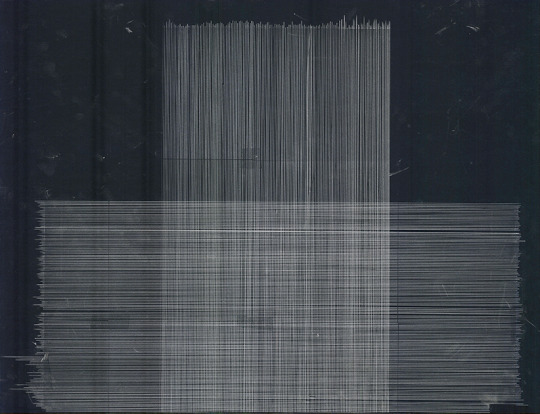
1 note
·
View note
Text
Words of Steve Chapman - A Guest Blog
I’m fascinated by human beings.
As a writer, speaker and coach specialising in creativity, I use art as a means of giving voice to that which words alone cannot express.
My current work explores the role that the super ego/inner critic plays in stifling creativity and how we can shine a positive light on shame through art. I use my art as a backdrop for talks and this year am speaking at TEDx and Cannes Lion on the subject of the Inner Critic. My big artistic influences are Daniel Johnstone, David Shrigley, Lynda Barry and my 10 year old daughter.
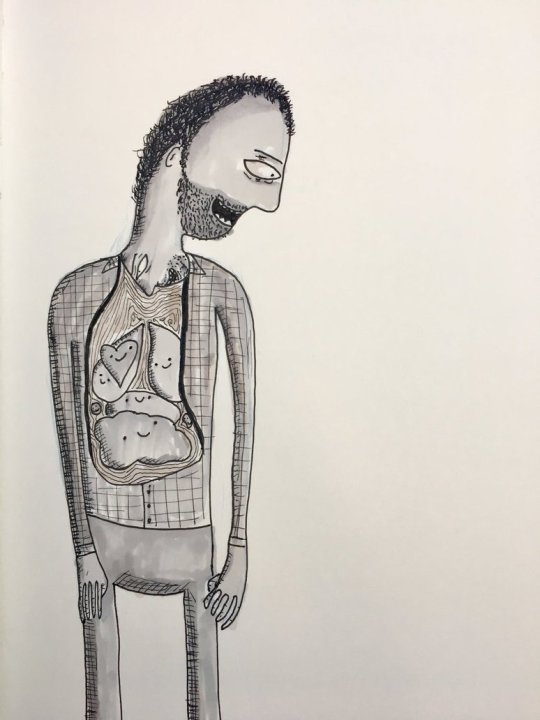
www.stevechapman.org
1 note
·
View note
Photo

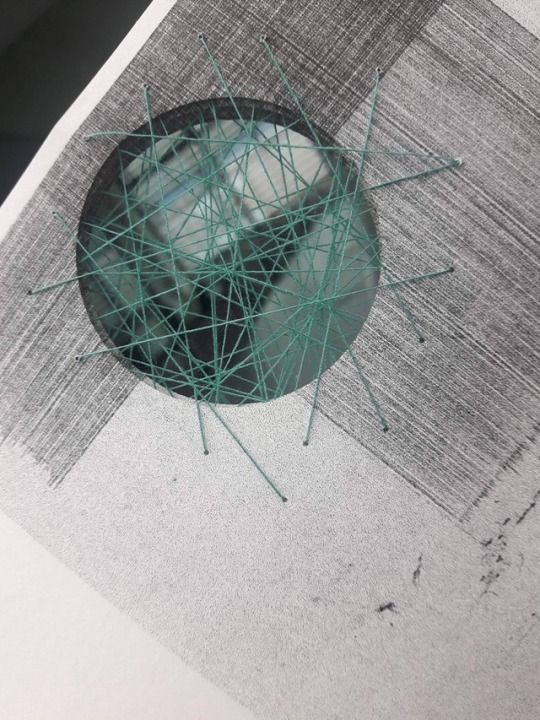

Guest blog by student coproducers Bethany, Faye and Rebecca. Three graphic design students were offered an open brief to design a participatory artist book that reflected the creative and aesthetic ethos of the Finding Lines project. We're delighted with the result. "After creating work for the finding lines exhibition as part of one of our university projects, we were all excited to see what else we could design, and how we could engage the audience to draw through a publication. The 25 bespoke publications have been hand crafted by myself Rebecca Leam, Bethany Wootton and Faye Brooks. The publication has been printed using the risograph onto a 200gsm Fabriano paper. We used a variety of processes to produce the publication, including laser cutting to remove sections in the publication and cut out the envelopes. We chose to have the publication hidden away within an envelope to give a precious and bespoke feel which we also enhanced with a letter pressed edition number 1 to 25. To add a more handcrafted and delicate feel, which is one of the key aspects to the brief, we hand stitched elements of the design with thread. This includes the two pockets each holding 3 small cards with a cropped section of artwork and a personal quote on the reversed side, for each of the contributing artists. Small bags containing fragments of drawing materials influenced by the artists processes have also been hand stitched onto the publication, to allow the audience to make their own marks."
#findinglines#design drawing#drawing#printed#graphic design#participatory art#exhibition#derbymuseum
3 notes
·
View notes
Text
Liz Atkin: artist statement for Finding Lines
Liz Atkin is an internationally acclaimed visual artist and advocate based in London.
Art has become her greatest tool for recovery after Compulsive Skin Picking dominated her life for more than 20 years. Drawing refocuses her hands and mind wherever she is, Liz reimagines the body-focused repetitive behaviour of skin picking into photographic artworks, charcoal drawings and performances.
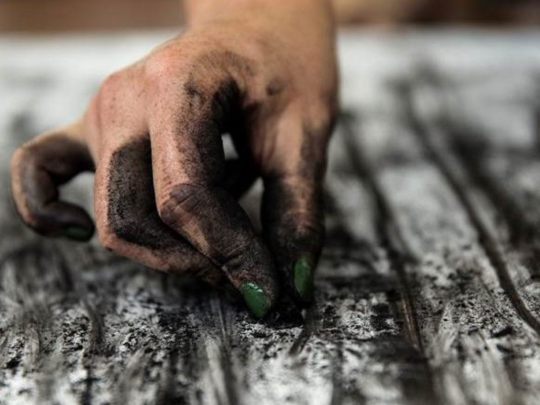
Her work has been exhibited in the UK, Australia, Singapore, USA and Japan. She has given public talks for TEDx, Wellcome Collection and at a range of conferences and health events around the world. Her artwork and advocacy has featured on BBC Radio 4 Woman’s Hour, Metro, Huffington Post, Women’s Health USA, i, Mashable, BBC World Service and more.
She’s known for her free #CompulsiveCharcoal drawings created on newspapers on public transport and gifted to passengers, she’s given away close to 10,000 drawings in the last year.
Most recently Liz was at M1 Singapore Fringe Festival gifting drawings, sharing her story and running advocacy workshops at universities and hospitals.
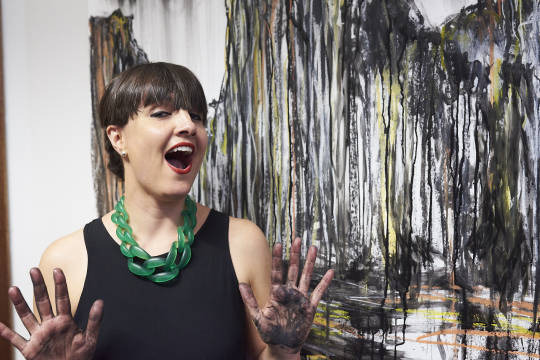
Photo: //www.davidjedge.uk
www.lizatkin.com
@lizatkin
0 notes
Text
#CompulsiveCharcoal
To occupy my hands I create free 1 minute drawings on discarded newspapers on public transport. I create up to 60 a day and give the drawings away to fellow passengers as advocacy for Compulsive Skin Picking and mental health, and as an act of kindness. In the last year, I’ve created more than 10,000 free drawings in London, New York and Singapore.
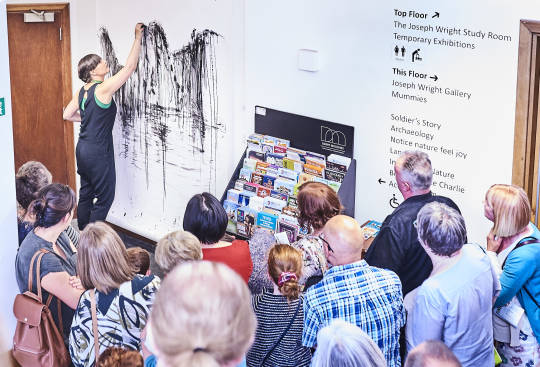
Pouring Mountains
As part of Finding Lines I’ll create a large performative drawing for opening event. Largely improvised, Pouring Mountains transposes the urge and energy of my Compulsive Skin Picking into a visceral charcoal drawing. These textural mountains are a radical re-thinking of a way to manage the disorder, the physical act of drawing helps release tension through my hands to the paper.
Photo: //www.davidjedge.uk
www.lizatkin.com
@lizatkin
1 note
·
View note
Photo
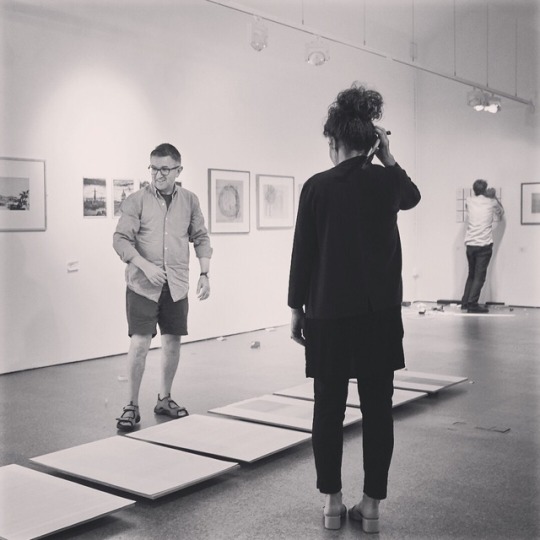
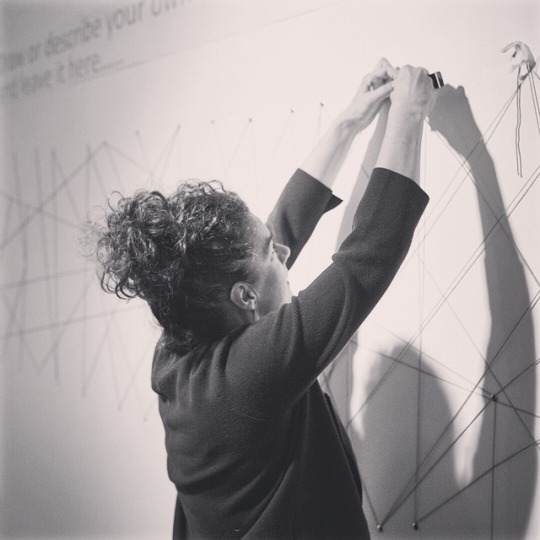
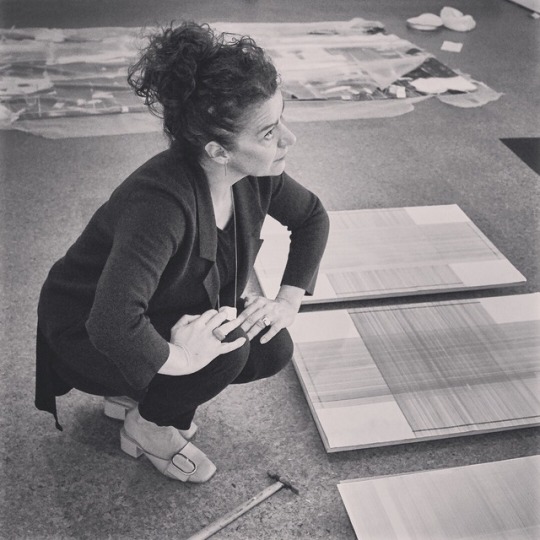
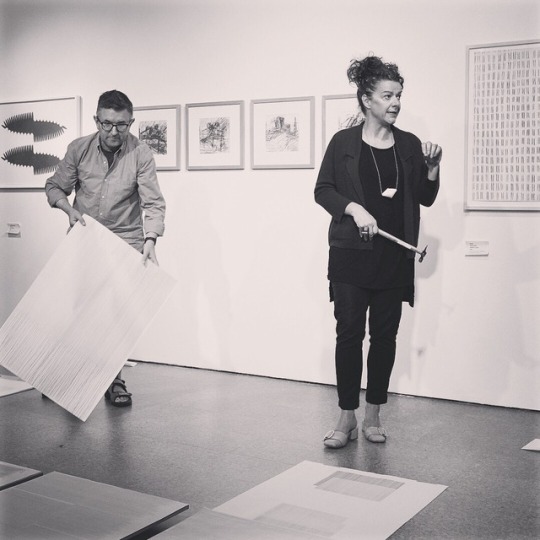
Installing 'Finding Lines', the Tim Shore day. The first week of install was filled with receiving loans, unpacking, paperwork and condition checking with fabulous colleagues. Next was the joyful task of laying out the sequence of drawings considering pace, visitor flow, sight lines and finding the beautiful moments of synchronicity that only occur when the art work reaches the gallery. The physicality of the drawings together in one room change the best laid plans. As this exhibition grew through a wonderful creative coproduction process, with each stage informing the next, an element of instinct and play came into getting the best possible layout. Once the majority of drawings were on the wall artist Tim Shore joined me (Andrea H-J) and technician Rick to lay his ten drawings onto a series of plinths marching down the centre of the room. We'd met to work through how this might be positioned and as the large drawings settled onto the plinths, as if floating just above the floor we gently secured them ready for the launch. Wonderful volunteer David Edge captured the day along with volunteers Monika and Holly gaining some work experience and offering new perspectives.
1 note
·
View note
Text
Statement on Drawing by Stephen Carley
Drawing is simply an ongoing process for me, a studio based process led dialogue between myself and the materials.
“There are no rules; drawing can be as minimal as a breath and as complex as the wave structures and recordings of the ocean. Drawing is kinaesthetic; a movement between points, a connection, recognition and gesture of any idea, mark, trace, line, symbol, shape, medium, space or surface”
Irene Barberis, from, The Good Drawing, CCW graduate school publications.
These drawings have absolutely everything in common with landscape, rural and urban. They are definitely not ‘abstract’ images.
They resonate with half remembered images and sounds of Sheffield, the Peak District, Cornwall, motorway journeys, walks in the sun, the sky through the attic window, bike rides, cracks in the pavement…
“It is impossible for me to make a painting which has no reference to the powerful environment in which I live”.
Peter Lanyon
Mixed media processes dominate with the use of pencil, charcoal, chalk, lead powder, collage and masking tape on paper. As a consequence of exploring what drawing is, they now include more fluid materials such as paint, varnish, dark room processes and found ‘urban detritus’ manipulated via the drawn visual language of tone, line, texture, shape and form.. Subsequently the drawings are evolving into audio 'versions’ or examinations of visual language through recorded, sampled, edited and looped arrangements.
A good drawing?
“A discourse between definition and the unresolved, the systematic and chaotic, certainty and speculation”.
Simon Betts, from, The Good Drawing, CCW graduate school publications.
The current drawings are very large - a little over eight feet wide and five feet high. It is physically demanding to make and move about. In fact it is almost ridiculous, but this takes me out of my comfort zone.
The audio starts as recognisable ‘riffs’ from a bass or tuned percussion or even a voice but become ‘deconstructed’ via a desktop sampler. Chopped up, tuned up or down, looped, reversed, made more ‘granular’.
Both elements are constantly egging the other on to deconstruct, to choose the less obvious. To enable ‘all the insecurities and doubts of the working process’ to show themselves.
The studio is also becoming more intrinsically ‘part’ of the work. The audio samples are taken live through a microphone and as a consequence the audio detritus of adjoining industrial workshops, adjacent houses, aircraft flying over, etc, are integrated. Likewise the floor, walls, workbench introduce graphic glitches into the drawing process as I cut, rub, spray, scratch, rip and reassemble the paper.
#drawing - a verb? It’s all about process, instinct, action, acute observation and memory…
stephen carley
www.stephencarley.co.uk
@stephen_carley
@c_y_h_m_n
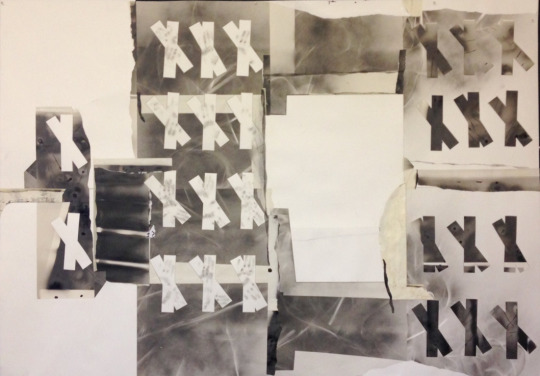
1 note
·
View note
Text
What does drawing mean to you?
We asked people "what does drawing mean to you?" To help us understand the part it plays in everyday lives. Thank you to the hundreds of people who responded openly, honestly and with humour. "
It’s a way to express ideas, gather meaning or a form of release.”
“Personally, because I’m rubbish at art, it means getting the lines wrong.”
“Pen/pencil and paper have become part of how I think, attend and imagine. I’m not so much a cyborg as a scribblorg.”

Photo: //www.davidjedge.uk
0 notes
Text
Friday 14 July 2017
Finding Lines
Finding Lines: a celebration of drawing and mark making exhibition was launched at Derby Museum and Art Gallery on Friday night. It was a great night with live drawing, performance and music.
My drawings float on ten plinths ranged in a line and raised about 10cms above the gallery floor. For most of the evening I anxiously watched as visitors carefully navigated around the gallery space and no one stepped on or tripped over them.
Here’s Andrea Hadley-Johnson (co-production and engagement manager) - also prime mover and curator of Finding Lines - introducing the exhibition and artists (with a Stephen Carley drawing on the wall behind).

And later here’s the same space from the other end and a conversation over and across my drawings but not I think about my drawings.
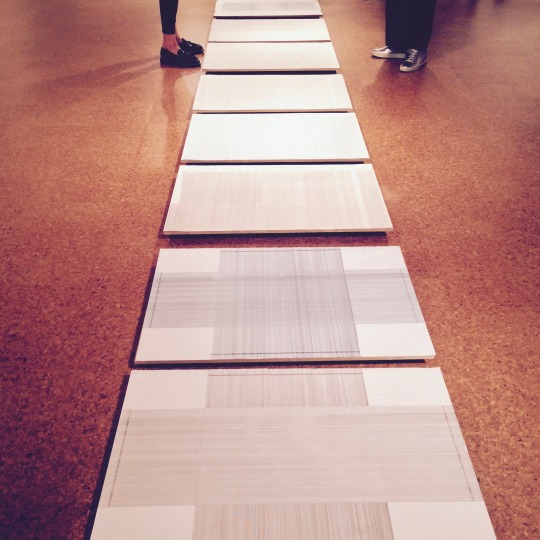
2 notes
·
View notes
Video
East Midlands Today responded to one of our drawing challenges. 'close your eyes and draw your face' always produces a fine set of lines and a smile …
0 notes
Text
Guest blog by Finding Lines artist Stephen Carley
Drawing. Process and exploration. Not knowing the answer. Asking questions. ‘They are not precisely views of the places through which he walks; instead… they reconstitute themselves as ‘aerial maps’, out of which recognisable landmarks emerge - a skyscraper, a mountain. He describes all of his drawings as ‘mental maps’, an appellation suggesting that each is a picture of his mind as it reacts to the stimulus of a particular environment’. Franz Ackerman. Motorway journey punctuated by dramatic weather changes - bright sunshine and clear blue sky, torrential rain and deep grey brooding clouds. Hazy sunshine and lens flare reflections rain distorted windows and swirling motorway spray… A bike ride in a dense mist over looping moorland reduced visibility to a handful of yards, everything flattened and silhouetted… no depth or space. No focus. The studio floor, caked in lead dust, fragments of acrylic and oil paint, bits of masking tape and discarded collage material now embroiled and integral to the drawing process. Residual marks and gestures, ghostly embossed surfaces, feint stains punctuate graphic clarity. Field recordings of the sea, waves gently breaking on a flat sandy beach, rhythmic, repetitive, organic. Push and pull. The walk to the studio, the wind thrashing the trees, blasting my ears, blocking and distorting, relentless. Still. Bird song. Siren. Drone. Branches stripped of leaves. Grey. Radio on. Radio off. Radio on. Radio off. Radio on. Radio off. Shadows reflect and light refracts through the kitchen window, a hyper bright Sunday afternoon… Angles, zigzags, swirling silhouettes of trees buffeted in the wind. Construct deconstruct reconstruct noise glitch no noise left to right edges hand eye white noise switch on switch off constant noise pulse beat… Today’s work is a springboard for further exploration… ‘I want to stay as close to the edge as I can without going over. Out on the edge you see all kinds of things you can't see from the centre’. Kurt Vonnegut. Stephen Carley. June 2017. stephen carley www.stephencarley.co.uk
0 notes
Text
Friday 5 May 2017
Pen Ruling Machine
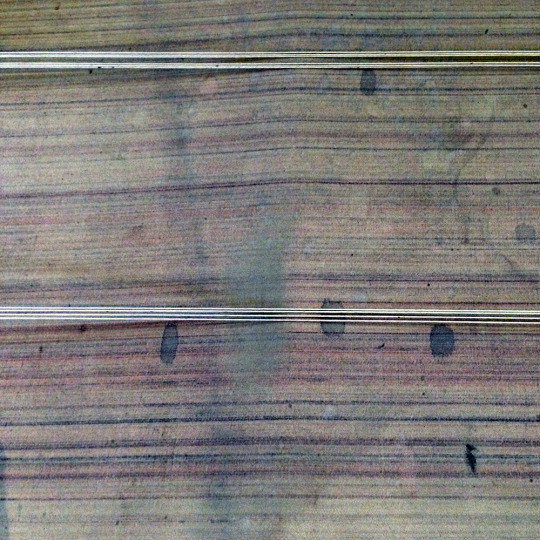
A couple of weeks ago I visited Wollaton Hall, Nottingham to see the Dance4 commission ‘Close Distance’ staged in the Prospect room at the top of the hall.
I also visited the Industrial Museum housed in the hall’s outbuildings and that is where I came across the Pen Ruling Machine.
It’s a machine that was used by printers to draw rules for ledgers and exercise books - anything that needed rules and columns. The image is of the machine’s top blanket onto which the paper was laid. The taut cords held the sheet in place as it passed under two rows of pens to be ruled with lines. The lines on the blanket must have been built up over many years of use, along with splatters of ink that break up the uniform pattern. There’s a video clip of a similar machine in use at the National Print Museum, Dublin https://www.youtube.com/watch?v=WmhqqRzzPgM.
For #FindingLines (Derby Museum’s upcoming drawing exhibition) I’m creating new drawings of multiple lines drawn by hand with the aid of simple tools like a ruler and chord to guide my drawn line. The image captures what I’m interested in: the gap between the head, hand and automation.
My ‘jigged’ drawings are by their nature durational (made in one sitting) and performative, because they are about the act of drawing. So I’m unsure what the drawings will be like ‘post stroke’. Drawing has the potential to be a mindful activity - doing the drawing could be understood as therapeutic. But as I am suffering from fatigue, the exertion of making the drawing and the time it will take will be difficult to manage and mistakes will be made.
And making mistakes is an important element of the project.
I use a metal rule to draw my lines, moving it incrementally across the surface of the paper as the drawing is made. But, as Tim Ingold notes in ‘Lines: A brief history’, the ‘workmanship of certainty’ (working with tools) where ‘things go straight to the point’ is ‘never that simple’. He writes:
‘no line that is ever drawn – even with a ruler – can be perfectly straight. An element of risk is always involved. For one thing, there is the constant danger that the ruler will slip. For another, the precise distance of the line from the edge of the rule will depend on the angle at which the pen is held, which is inclined to vary in following through the manual gesture.’
The production of the drawings is governed by rules that I cannot meet. I have devised an activity that pitches the production of the drawing against factors like tiredness, concentration, measurement and correctness.
2 notes
·
View notes
Photo
Kayleigh, Dan and Ari are sharing our little pack of drawing cards in Derby Royal Hospital, they're doing an amazing job in encouraging mindful moments and everyday acts of creativity. Top volunteers.


Drawing Card 6: Draw your mood. Expectant, like waiting for a cup of tea.
Drawing Card 7: Draw what makes you happy. A bus arriving on time. By special guest Ari.
Our day on the Drawing Card project at Derby Hospital was good and we gave out lots. This week we have placed a box and some cards in one of the waiting rooms and we’ll see what we get me to week. We also handed over some cards in another waiting area and while watching what people did with the cards me and Ari picked one each to draw, the results are above. Ari filmed me drawing mine and will make a short animation of it so I’m looking forward to that. We had some positive feedback from a few nurses who took the cards back for some for their young patients. All in all it was good 2 hours of getting the cards out there in the hospital and getting some more thoughts how to make it work better next time.
4 notes
·
View notes
Text
Guest blog number 2 by Genkai Claire Breeze 'a long walk to the centre'
A long walk to the centre
December 2014 in a retreat centre in Dorset. It is Saturday night and I have laid a labyrinth out in the meditation hall. Hand stitched in the Chartres Cathedral design it fills the room with a sequence of parallel pathways and rounded corners eventually arriving at a central area. The heart of the labyrinth.
A woman I know well is beginning to walk the labyrinth supported by two friends. She is bald, swollen and unstable. She is dying from cancer. Everyone else is silent. Transfixed by her slow faltering steps and the energy of concentration and pathos as she follows the lines before her. It takes her 30 minutes to arrive at the centre. Her breathing is laboured, her face is streaked with tears, and all those also walking the labyrinth are aware of the undeniable truth she is offering us. Calming and smiling she begins her walk away from the centre out and along the stitched lines on the ground. As she passes fellow walkers they stop to hug and kiss before moving past each other.
Lines on the ground and in the centre a clear space absent of markings.
November 2015 in the Cotswolds and the labyrinth is once more laid out on the floor. I find myself dancing, skipping and moving with freedom along the paths she walked eleven months before. Her lifeline came to an end six months before, and yet the lineage of her journey is lifting my feet in appreciation.
0 notes
Text
Drawn to look: a guest blog by Susan Kester
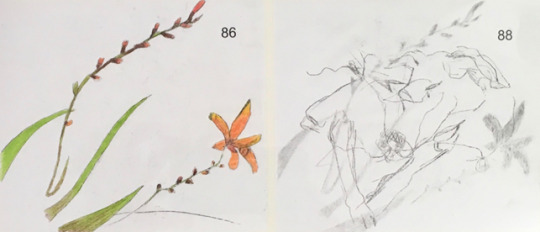
‘We sleep through our lives in a dreamless sleep.
But where is our life? Where is our body?
Where is our space?
George Perec (1936-82)
For the past year or two I have used cheap duplicate books as sketchbooks to create 'carbon copy' drawings. In these books, I simply make a record of small incidents, encounters or memories, much like a diary. I enjoy maintaining a balance between the skills that come from the deliberate sustained practice of drawing and the delightful encounters with happenstance captured in the unexpected and uncontrollable qualities of the 'blind' copy. This deliberate courting of the accidental helps to brings the drawings to life and makes way for the possibility of discovery.
Looking and recording through a simple process of lines and marks on paper connects nicely with the images that are coming up under #findinglines. Here we can see an engagement with the everyday by direct observation of line within daily routines. I am interested in this close observation of the world around us. A purposeful engagement with our immediate surroundings, that brings into focus the details of life that are often taken for granted or overlooked. There are images of lines created by the suns warmth on the frosty pathway, tracks through the damp grass from walking the dog, vapour trails in the beautiful clear blue of a summer sky. These lines that overlay and interrupt the landscape we move through, both urban and rural, are reminiscent of the lines of a drawing that interrupt the blank page of the sketch book.
Susan Kester
http://www.susankester.co.uk/
https://www.instagram.com/susan.kester/
[1] Perec, G., Species of Spaces and Other Pieces, Penguin Books, London, 1997, p.210
0 notes
Photo
Three amazing volunteers are taking the Finding Lines drawing cards into Derby Royal Hospital to share with patients. The prototypes enabled moments of mindfulness, distraction and conversation. Here, volunteer Dan @mangus2000 makes some of his own fantastic marks

“Close your eyes and draw your face”. My attempt at one of the Drawing Cards.
2 notes
·
View notes